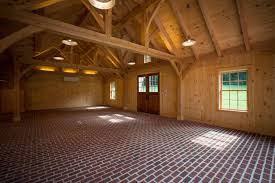A brick garage floor can add a touch of rustic charm and durability to your garage. While it may not be the most common type of flooring for a garage, it is certainly a viable option that has several advantages. In this article, we will explore the benefits of a brick garage floor, the installation process, and some tips on how to maintain it.
Benefits of a Brick Garage Floor
Durability: Brick is known for its durability and strength. A brick garage floor can withstand heavy vehicles, equipment, and foot traffic without cracking or chipping. It is also resistant to moisture and weather, making it a long-lasting solution for your garage flooring.
Low Maintenance: A brick garage floor requires minimal maintenance compared to other types of flooring. It is easy to clean and does not require any special cleaning products or equipment. You can sweep or mop it regularly to keep it looking clean and polished.
Slip-Resistance: The texture of a brick garage floor provides excellent slip resistance, making it a safe option for garage flooring. It can prevent accidents and injuries that may occur due to slippery surfaces.
Aesthetics: A brick garage floor can add a unique and rustic look to your garage. It can complement any design style and enhance the overall appearance of your garage.
Installation Process
Installing a brick garage floor requires some preparation and planning. Here are the steps involved in the installation process:
Prepare the Surface: The first step is to prepare the surface of the garage floor. The surface should be level and free of any debris, oil stains, or cracks. You can clean the surface with a pressure washer and fill any cracks with concrete filler.
Create a Base: The next step is to create a base for the bricks. You can use a layer of sand or gravel as a base. Make sure the base is level and compacted.
Lay the Bricks: Once the base is ready, you can start laying the bricks. You can use any pattern or design you like. Make sure the bricks are level and evenly spaced. You may need to cut some bricks to fit them around the edges and corners.
Secure the Bricks: Once all the bricks are laid, you can secure them in place by filling the gaps between them with sand. You can also use a sealer to protect the surface and enhance the color of the bricks.
Tips for Maintaining a Brick Garage Floor
Clean Regularly: Sweep or mop the floor regularly to keep it clean and free of debris. You can also use a pressure washer to remove any stubborn stains or dirt.
Seal the Surface: Apply a sealer to the surface of the bricks every few years to protect it from moisture and stains. A sealer can also enhance the color and shine of the bricks.
Repair Any Damage: Inspect the floor regularly for any cracks or damage. Repair any cracks or damage immediately to prevent further damage.
Use Mats or Rugs: Place mats or rugs in high-traffic areas or areas where there may be oil or chemical spills. This can help protect the surface of the bricks and prevent any stains.
In conclusion, a brick garage floor is a durable, low-maintenance, and aesthetically pleasing option for your garage flooring. With proper installation and maintenance, it can last for many years and provide a unique and rustic look to your garage.

